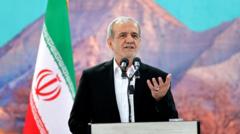In a recent turn of events, Iranian President Masoud Pezeshkian has reportedly been injured in an Israeli airstrike aimed at a covert military facility in Tehran. This strike, which occurred on June 16, is said to have targeted strategic access points at an underground site where Pezeshkian was participating in an emergency meeting of the Supreme National Security Council. According to Iran's Fars news agency, closely affiliated with the Revolutionary Guard, he suffered leg injuries while evacuating through an emergency escape route.
Pezeshkian, who previously accused Israel of an assassination attempt—claims that were promptly rebuffed by Israeli officials—is now under scrutiny as Iran investigates potential Israeli infiltration within its borders. The Fars report indicates that the Israeli bombardment managed to incapacitate all six entry and exit points to the facility, as well as the ventilation system. Power supply was also cut off, heightening the danger for attendees, including Pezeshkian, who eventually evaded critical harm.
Reports of extensive damage emerged from north-west Tehran, where videos captured heavy bombardment throughout a 12-day conflict. While specifics regarding strategic intelligence on the location of Iranian leaders have yet to be clarified, Israeli officials did acknowledge targeting the Supreme Leader Ayatollah Ali Khamenei, though they lost track of him as he relocated to a more secure site. This revelation brings a new layer of complexity to the ongoing tensions between Iran and Israel, especially regarding nuclear development, which Israel alleges Iran is pursuing.
On June 13, a pre-emptive Israeli attack on alleged nuclear and military installations was justified by the government as essential for preventing Iran from developing nuclear weapons. Iran has continually denied these allegations, maintaining that its nuclear program serves peaceful purposes. The conflict escalated further on June 22, when the US executed airstrikes against Iranian nuclear sites, a move President Trump later described as devastating to Iran’s military capabilities.
As tensions escalate, questions linger regarding the future of Iranian governance and the delicate balance of power in the region, with Pezeshkian's reported injuries indicating a precarious moment for Iran's leadership amidst hostilities.
Pezeshkian, who previously accused Israel of an assassination attempt—claims that were promptly rebuffed by Israeli officials—is now under scrutiny as Iran investigates potential Israeli infiltration within its borders. The Fars report indicates that the Israeli bombardment managed to incapacitate all six entry and exit points to the facility, as well as the ventilation system. Power supply was also cut off, heightening the danger for attendees, including Pezeshkian, who eventually evaded critical harm.
Reports of extensive damage emerged from north-west Tehran, where videos captured heavy bombardment throughout a 12-day conflict. While specifics regarding strategic intelligence on the location of Iranian leaders have yet to be clarified, Israeli officials did acknowledge targeting the Supreme Leader Ayatollah Ali Khamenei, though they lost track of him as he relocated to a more secure site. This revelation brings a new layer of complexity to the ongoing tensions between Iran and Israel, especially regarding nuclear development, which Israel alleges Iran is pursuing.
On June 13, a pre-emptive Israeli attack on alleged nuclear and military installations was justified by the government as essential for preventing Iran from developing nuclear weapons. Iran has continually denied these allegations, maintaining that its nuclear program serves peaceful purposes. The conflict escalated further on June 22, when the US executed airstrikes against Iranian nuclear sites, a move President Trump later described as devastating to Iran’s military capabilities.
As tensions escalate, questions linger regarding the future of Iranian governance and the delicate balance of power in the region, with Pezeshkian's reported injuries indicating a precarious moment for Iran's leadership amidst hostilities.




















